Last month you learned the steps to creating a comprehensive fleet safety program. Those steps included defining a “safe” fleet, monitoring performance, training drivers, and measuring and rewarding safety. Teletrac Navman is back this month to share tips on fleet safety.
After assessing the factors causing risk in a fleet and identifying recurrent issues stemming from poor driving performance, the next phase is to put new safety measures in place or expand upon ones already established.
To create a fleet-wide culture of safety, it is critical to first ensure that you have full participation and commitment from senior management, as they are ultimately responsible for the safety of all employees. It is also their duty to provide the necessary education, training, and resources for employees to practice safe habits.
Once you’ve received support from the leadership team, use this 10-step checklist to build a comprehensive safety program and greatly minimize risk:
- Develop written safety management policies and procedures.
Responsibilities and expectations of all staff (managers, drivers, administrators)
Driver safety and vehicle assignment agreements
Fair, objective disciplinary action system - Disseminate written policies throughout the organization.
Policies included in employee handbook
Overview of policies during new hire orientation
Regular (monthly, quarterly) safety meetings - Decide minimum standards for screening and employing safe drivers.
Valid Class A, B, or C Commercial Driver’s License (CDL)
Motor Vehicle Report (MVR) check and evaluation
Age requirements in compliance with state or federal laws - Implement comprehensive driver safety training.
Curriculum customized to driver’s experience level
Routine instruction on defensive driving procedures
Access to training materials and resources at any time - Establish distracted or impaired driving policy.
Training on visual, cognitive, manual distractions
Driver commitment not to use cell phones while operating vehicle
Instruction given to drivers operating new or unfamiliar vehicles
Randomized drug and alcohol testing - Monitor driver performance through regular evaluation.
Driver Scoreboard and DVIR checks
Health examinations by DOT/FMCSA
Roadside DOT inspection reports
On-road performance assessment - Set cadence of vehicle inspection and maintenance.
Responsibility of driver to maintain equipment and report issues
Training for personnel performing maintenance activities per FHA standards
Establish schedule of planned maintenance (vs demand)
Daily inspection of fluid levels, lights, tires, safety equipment by driver
Maintain communication loop for reporting vehicle defects and safety concerns - Institute system for driver disciplinary action.
Strategy for unmet expectations and terminable offenses
Remedial training for drivers involved in unsafe event
Document instances of disciplinary action to track trends - Create driver incentive program and reward top performers.
Monthly budget set aside for safety bonuses and improvements
Gifts or monetary rewards readily available for on-the-spot recognition
Driver Scorecards used to prevent fraudulent achievements - Formalize procedures for accident reporting and analysis.
Provide accident reporting kits and train drivers on contents
Review all accident or damage reports to take immediate corrective action
Conduct accident investigations routinely to identify at-risk drivers
Analyze accident and damage trends to measure long-term results
FOR MORE INFORMATION
Teletrac Navman is a fleet management solutions software company. Teletrac Navman provides you with the data to stay on schedule, reduce costs, and put your team and vehicles to work every day. Find out more, visit www.teletracnavman.com.
MODERN WORKTRUCK SOLUTIONS: OCTOBER 2018 ISSUE
Did you enjoy this article?
Subscribe to the FREE Digital Edition of Modern WorkTruck Solutions magazine.
![]()





